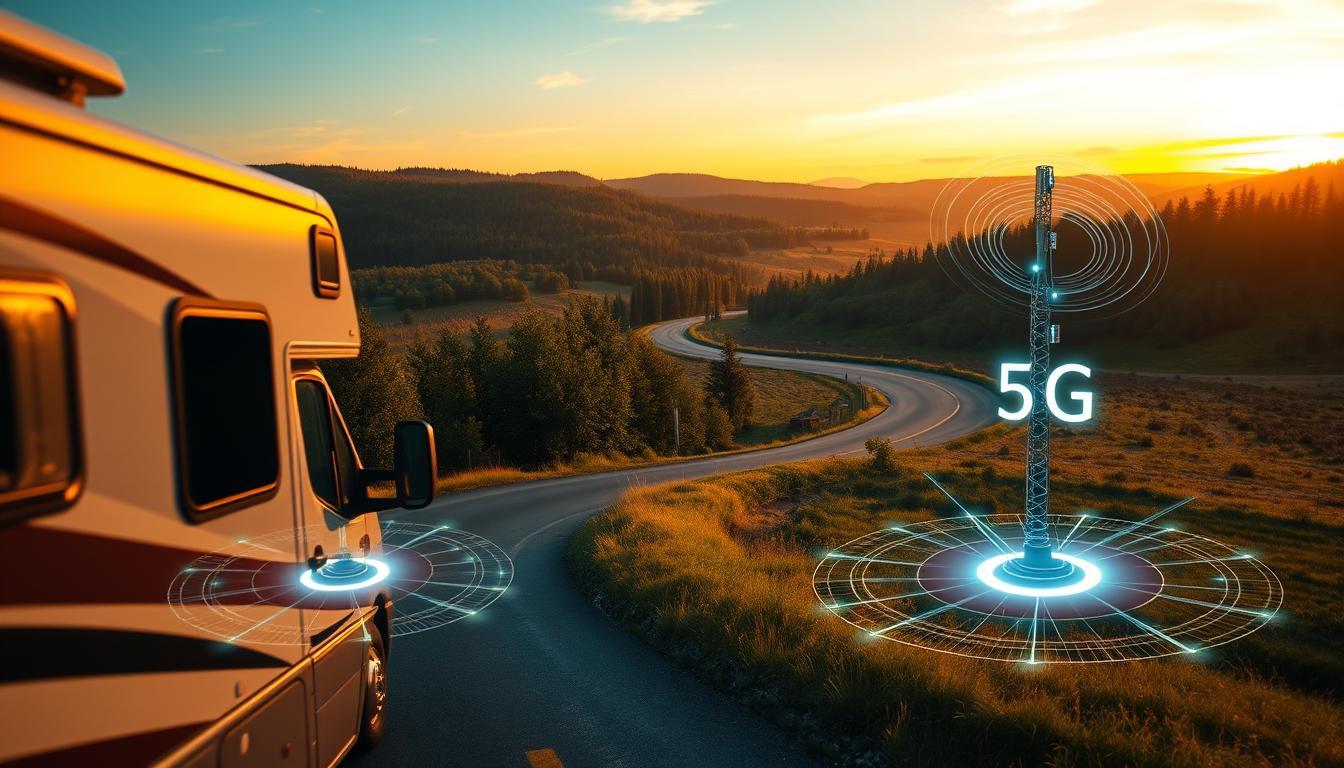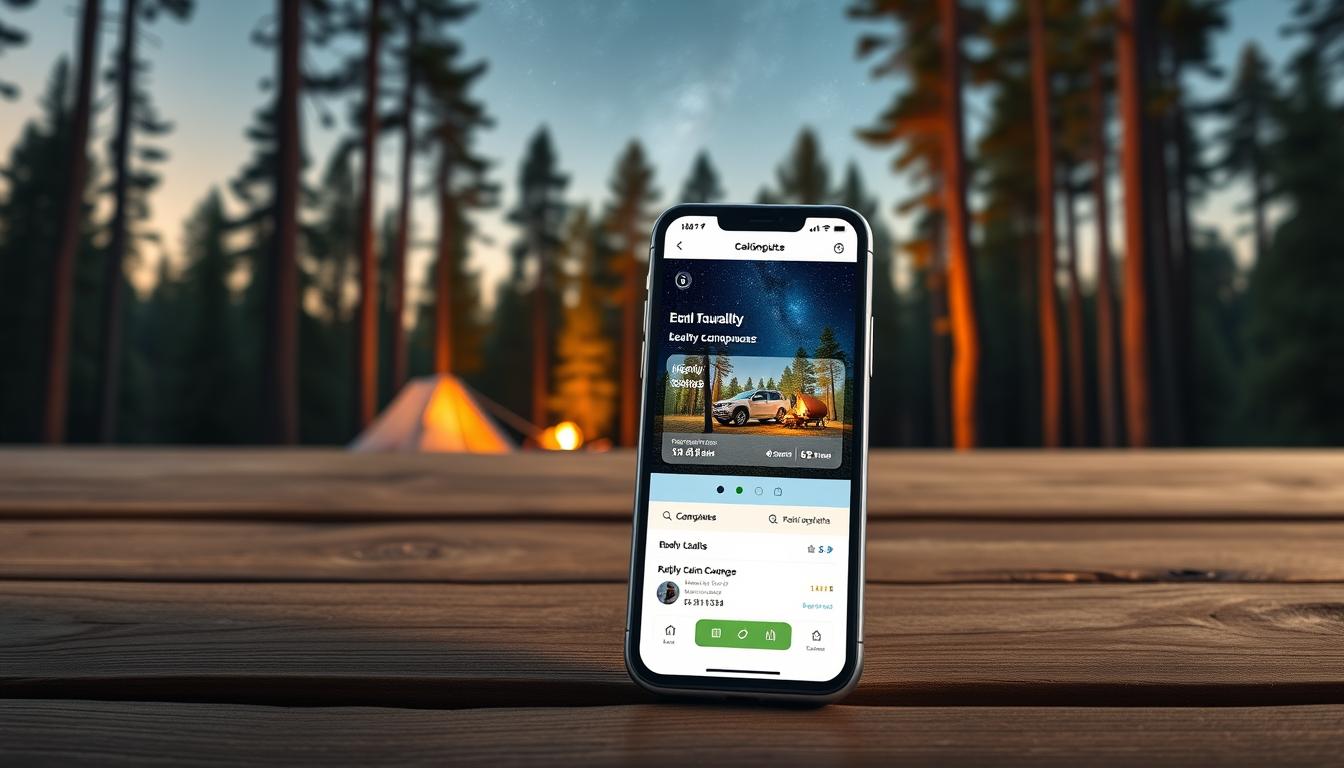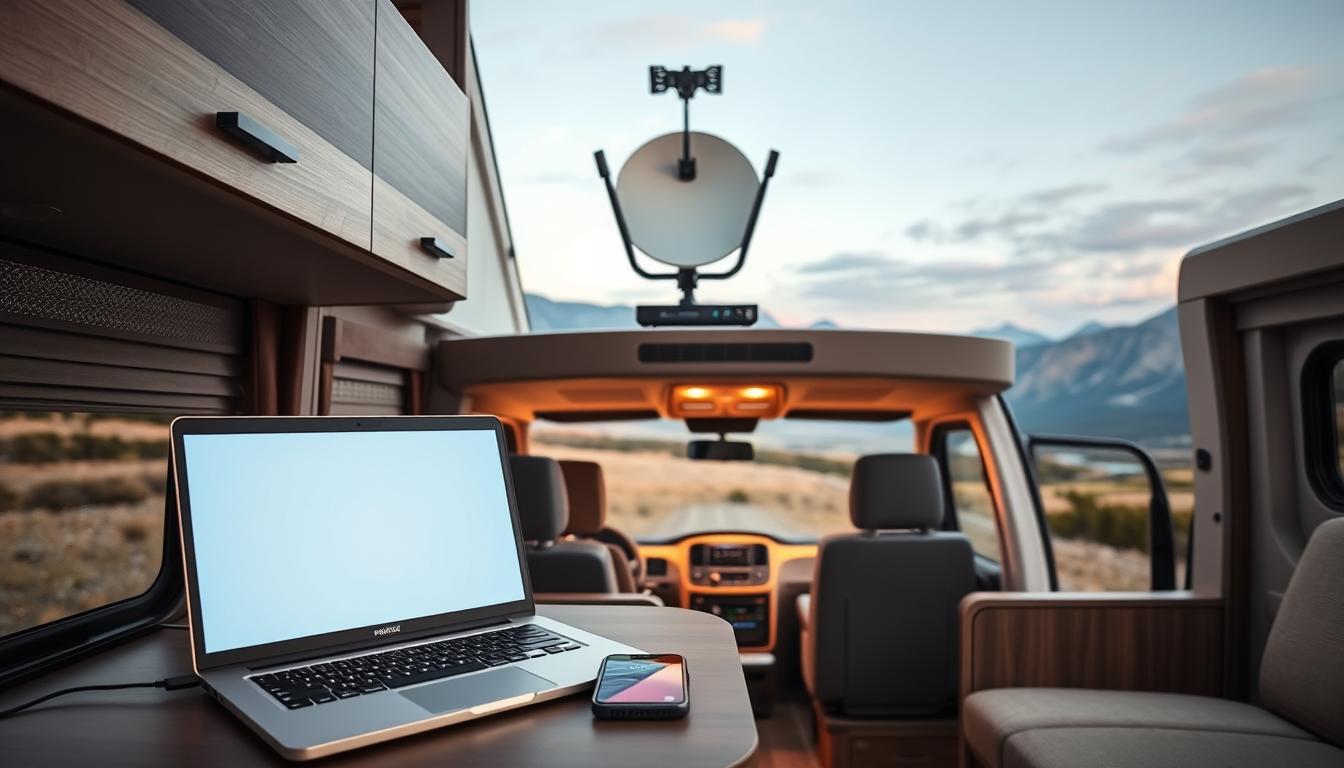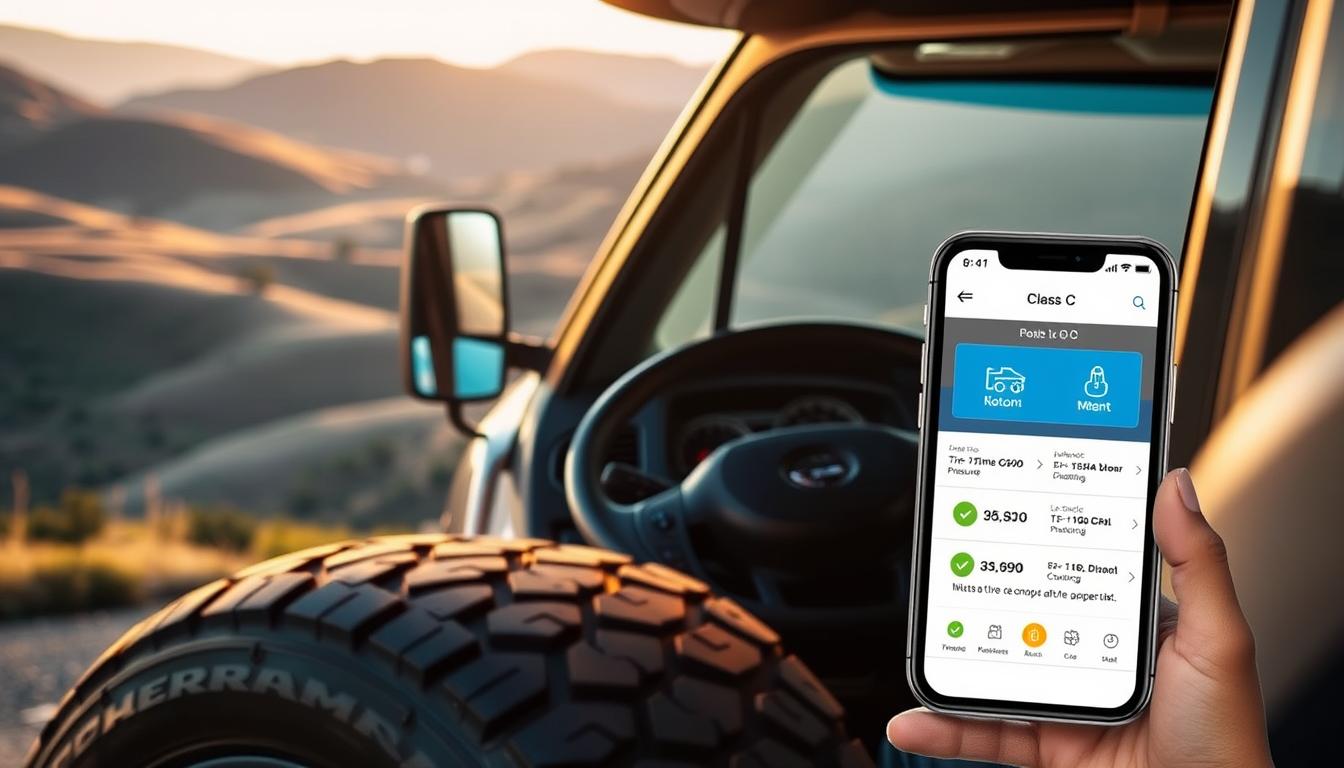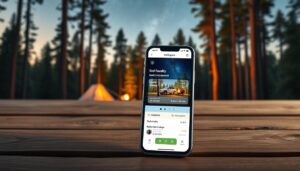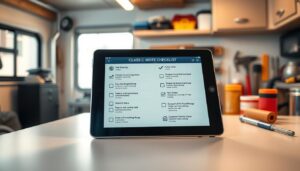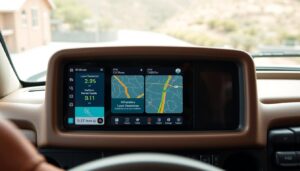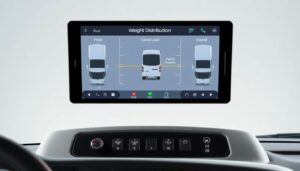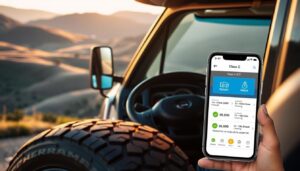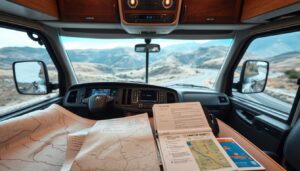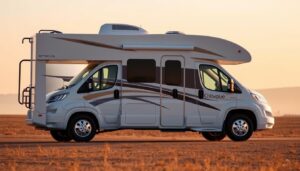Apps for Identifying 4G/5G Coverage Areas on Class C Motorhome Routes
Are you ready to explore in your Class C motorhome but concerned about staying online? Knowing about 4G and 5G coverage is key to a great trip. With more people needing internet on the go, finding good spots for your motorhome is essential.
We’ll look at how apps and RV maps can help. They guide you to places with strong internet. This is vital for enjoying shows by the campfire or finding your way.
Introduction to Connectivity on the Road
Travelers in Class C motorhomes focus on staying connected. This is key for those exploring the outdoors. Mobile connectivity is now a must, not a luxury. It lets travelers keep in touch, use maps, and enjoy shows on the go.
Having good internet access makes RV travel better. It’s great for sharing views with loved ones or checking the weather. Thanks to 4G and 5G, staying connected is easier than before.
Staying connected is more than just a convenience; it’s about safety and access. RV fans can quickly call for help in emergencies. They also use apps to make their trips better. This shows how important it is to stay connected while traveling.
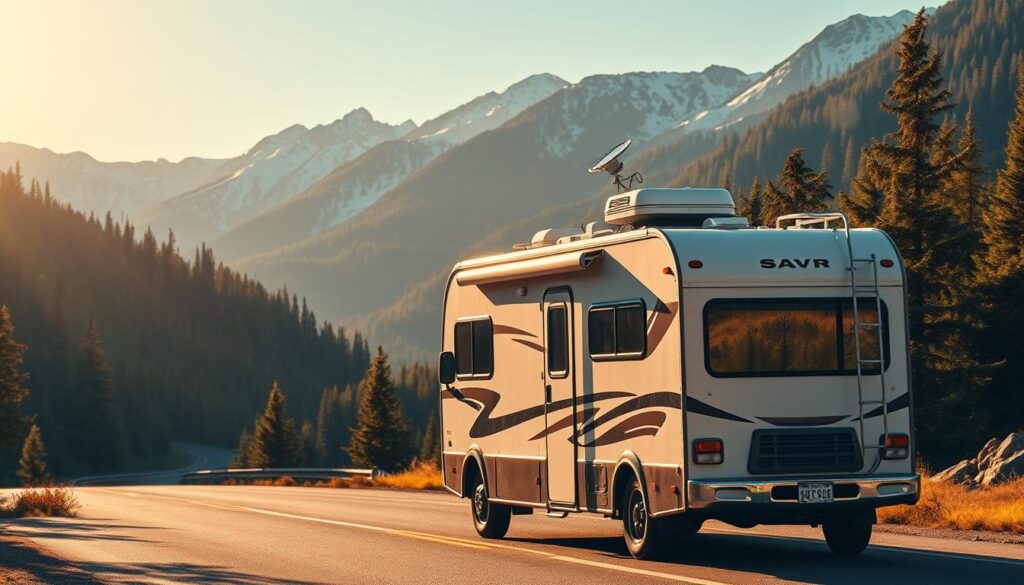
Importance of 4G/5G Coverage for Class C Motorhomes
For Class C motorhome fans, having good mobile coverage is key. It lets them stay in touch with loved ones while traveling. Many use the internet for navigation, making trips smoother and safer.
Strong mobile networks also make trips more fun. They allow for streaming movies and shows, great for long drives. For those who work remotely, reliable internet means they can stay productive on the road.
Most motorhome owners are unhappy with their coverage, showing how important it is. Being able to stay connected makes trips more enjoyable. It helps families create lasting memories on their travels.
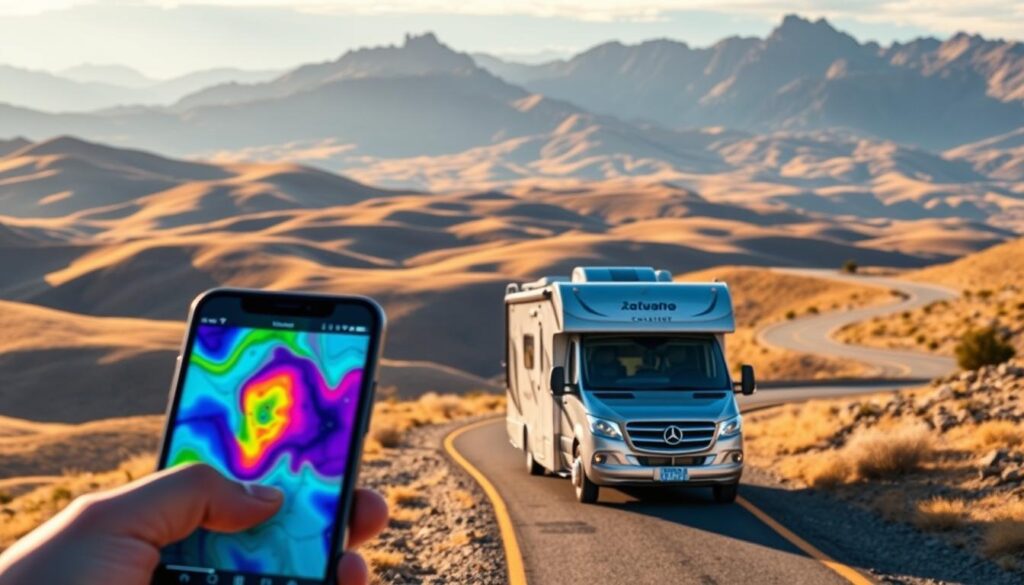
| Aspect | Impact |
|---|---|
| Family Communication | Allows for instant contact with loved ones during trips |
| Navigation | Helps in route planning and avoiding traffic |
| Entertainment | Facilitates streaming of movies and shows during travels |
| Work Capability | Enables handling of professional responsibilities on-the-go |
In short, having reliable 4G and 5G coverage makes traveling in Class C motorhomes better. It brings peace of mind and makes the journey more enjoyable.
How 4G and 5G Technology Works
It’s important to know how 4G and 5G technology work. They use radio waves to send data between devices and cell towers. The network’s design is key, with 5G adding new features for better connectivity.
4G offers fast speeds, like broadband. It uses different frequency bands for communication. The Long-Term Evolution (LTE) protocol improved it from 3G. Now, users enjoy better video streaming and faster downloads.
5G takes mobile tech to the next level. It can reach speeds of up to 10 Gbps. This is thanks to millimeter waves and more small cell towers. It also means lower latency, making things like gaming and video calls smoother.
Let’s look at the main differences between 4G and 5G:
| Feature | 4G Technology | 5G Technology |
|---|---|---|
| Data Speed | Up to 1 Gbps | Up to 10 Gbps |
| Latency | 30-50 ms | 1 ms |
| Network Capacity | Up to 100,000 devices/km² | Up to 1 million devices/km² |
The move from 4G to 5G is more than just speed. It also means more devices can connect at once. This is great for crowded areas or big events. With these updates, mobile tech keeps getting better, offering new ways to stay connected.
Understanding Signal Strength and its Metrics
Signal strength is key for reliable cell phone connections, especially for Class C motorhome travelers. Knowing the signal strength helps users check their connection and if they need signal boosters. Cell phones show signal strength with bars, but these are not very precise.
To get a better grasp of signal strength, look at decibel milliwatts (dBm). This unit gives a clearer view of signal quality. Cell phone signal strength falls into different ranges:
| Signal Quality | dBm Range |
|---|---|
| Outstanding | -50 dBm to -70 dBm |
| Good | -71 dBm to -85 dBm |
| Fair | -86 dBm to -100 dBm |
| Poor | -101 dBm or lower |
By knowing these metrics, travelers can find reliable connection spots. They can also see when they need a signal booster. Understanding signal strength makes traveling better by keeping communication smooth.
Identifying 4G/5G Coverage Areas on Class C Motorhome Routes
Traveling in a Class C motorhome is exciting. You get to see different landscapes. But, it can be hard to find reliable internet. Knowing how to deal with these issues makes your trip better.
Overview of Coverage Challenges for RV Travelers
RV travelers often face spotty cell service. Mountains, valleys, and forests can block signals. This makes staying connected hard.
But, cities usually have better coverage. Out in the country, it’s often weak or non-existent. Knowing where you can get a signal helps plan your trip.
Factors Affecting Signal Strength on the Road
Several things affect your internet while traveling. How far you are from cell towers is key. The farther away, the weaker the signal.
Different networks also perform differently in different places. Knowing this helps pick the best network for your trip.
Top Apps for Finding Cell Towers
Traveling in a Class C motorhome can be tough without a good internet connection. Cell tower locating apps help by showing nearby towers. Wilson Amplifiers’ Cellular Tower Finder is one such app. It tells you how far away a tower is and what frequency it uses.
There are also apps that use data from many users. These apps show how good the coverage is in your area. They also share tips on signal strength changes. Using these apps with other methods can help you stay connected on the road.
Here’s a look at some popular apps for finding cell towers:
| App Name | Features | Best For |
|---|---|---|
| Wilson Amplifiers’ Cellular Tower Finder | Distance to towers, frequency bands | Precise tower location |
| OpenSignal | Crowd-sourced signal data, coverage maps | User-generated insights |
| CellMapper | Live network data, cell tower maps | Real-time coverage tracking |
| Network Cell Info Lite | Detailed signal metrics, historical data | In-depth coverage analysis |
Using the right apps can make your trip better by improving your internet. Knowing where cell towers are and their strength is key in remote places. Spending time on these apps can greatly enhance your travel experience.
Signal Testing Apps: Key Features
Staying connected while traveling is key for Class C motorhome users. Signal testing apps help evaluate and improve connectivity. Apps like weBoost, OpenSignal, and Network Cell Info offer unique features for signal testing.
weBoost App: Your Signal Assistant
The weBoost app is a trusted ally for better cellular signals. It helps find the nearest cell towers for stronger signals. With an easy-to-use interface, weBoost makes signal testing simple, helping travelers make smart choices about their connection.
OpenSignal: Crowdsourced Data Insights
OpenSignal is a top app for signal insights. It uses data from users to show real-time coverage maps. This app helps find the best signal spots and shows where signals are weak.
Network Cell Info Lite: Comprehensive Coverage Analysis
Network Cell Info Lite is known for its detailed coverage analysis. It shows signal strength, network type, and location-based metrics. Its easy-to-use design makes it a must-have for Class C motorhome travelers to keep their connection strong.
Mapping Cellular Coverage
For RV travelers, staying connected is key. Cellular coverage maps help them see where signals are strong and weak. These maps show where 4G and 5G networks are available, helping travelers plan their trips.
Apps and websites help RVers find the best signal areas. This info is great for finding places to stop and stay connected. It means no more dropped calls or lost internet.
Using coverage maps makes traveling better. RV owners can check routes and choose stops with good service. This way, every trip is fun and connected.
| Provider | Coverage Quality | Notes |
|---|---|---|
| Verizon | Excellent | Strong coverage across most rural areas |
| AT&T | Good | Reliable service with some weak spots |
| T-Mobile | Varies | Best in urban settings, weaker in rural locations |
Travelers should check these maps often. This ensures they stay connected on their adventures. By focusing on coverage, RV trips become smooth and enjoyable.
Using Speed Test Applications Effectively
Travelers often use the internet for navigation, communication, and fun. Knowing your internet speed is key for a good online experience on the road. Speed test apps help you check your network’s performance, guiding you to the best internet options.
By regularly testing your speed, you can keep an eye on your upload and download speeds. This is important for smooth online activities.
Importance of Speed Tests for Travelers
For Class C motorhome users, speed tests are a must-have. They help find reliable networks, especially in areas with poor coverage. With speed test apps, you can find the best times and places for internet access.
This ensures you can use email, stream videos, or make video calls without interruptions. It helps plan your route based on internet quality, avoiding unexpected issues.
Recommended Speed Testing Apps
Many speed test apps are available, each with its own strengths. Ookla Speedtest is a favorite for its easy-to-use interface and accurate results. FAST, from Netflix, is quick and simple for basic tests.
Other top picks include Meteor and Speedcheck, which provide detailed performance data. Using these apps helps you decide on signal boosters or network changes based on your current speed.
Making the Most of Your Signal Strength Data
Travelers can greatly benefit from understanding and using their signal strength data. It’s key to improving connectivity on road trips. By watching the readings, people can choose better routes for a strong connection.
Understanding signal strength data can change your travel experience. If you see a big drop, it might mean finding new routes or better coverage areas. Keeping track and analyzing this data helps make travel plans better, keeping you connected.
Using mobile strategies like finding better signal areas helps a lot. If the signal gets too low, moving or using a signal booster in your motorhome is a good idea. This keeps your connection strong, making your trip better.
Choosing the Right Signal Boosters for Your Motorhome
Choosing the right signal boosters for a Class C motorhome is important. Not all boosters are the same. It’s key to find ones that meet your needs. For RV travelers, the right RV cell signal boosters can greatly improve connectivity.
Two top brands are weBoost and SureCall. They offer many options. Knowing what each brand can do helps you make a better choice. The best boosters have high gain levels, which means they can strengthen weak signals.
| Brand | Model | Gain Level (dB) | Coverage Area (sq. ft.) |
|---|---|---|---|
| weBoost | Drive 4G-X OTR | 50 | 5,000 |
| SureCall | Fusion2Go 3.0 | 50 | 15,000 |
| weBoost | Drive Sleek | 23 | 1,500 |
| SureCall | Roam 4G-X | 60 | 10,000 |
When picking the best boosters, think about your vehicle and signal conditions. Also, consider what you prefer, like ease of use and portability. By carefully looking at these factors, you can keep a strong cellular connection anywhere you go.
Future of Cellular Technology on the Road
The future of connectivity on the road is exciting for RV travelers. With the growth of 5G, internet access will get faster and more reliable, even in remote spots. This is great for those who need internet for work and fun while traveling.
Self-optimizing cellular antennas are on the rise. They adjust to changing environments to get the best signal. Also, integrating Internet of Things (IoT) devices into motorhomes will be key. This will let travelers check on their vehicle, manage energy, and get live navigation updates easily.
As mobile tech improves, using remote streaming, video calls, and social media on the go will get easier. New data compression methods will help even in areas with slow internet. RV fans can look forward to better mobile connectivity making their outdoor adventures even better.
Conclusion
Understanding the importance of 4G and 5G coverage is key for Class C motorhome travelers. Good connectivity means better communication, navigation, and access to info. This makes traveling more enjoyable.
Using the right apps and tools helps find the best signal areas. This ensures a great experience on the road and at your destinations.
As mobile tech for travel gets better, knowing about signal strengths and coverage is crucial. Each tool helps improve connectivity on your adventures. Using these tools helps make travel worry-free and fun.
By improving connectivity on the go, travelers can enjoy their trips more. They can stay in touch with family and get important services when needed. Good connectivity makes every journey fulfilling, opening up new places to explore.
FAQ
Why is reliable 4G and 5G coverage important for Class C motorhome travelers?
Reliable 4G and 5G coverage is key for Class C motorhome travelers. It lets them stay connected for calls, navigation, streaming, and work. Good coverage makes their travel better by keeping them connected without breaks.
What are the differences between 4G and 5G technology?
4G offers decent data speeds and moderate latency. 5G, on the other hand, has much faster speeds, less latency, and more network capacity. This makes 5G great for travelers who need fast data.
How can signal strength be measured accurately?
Signal strength can be measured in decibel milliwatts (dBm). Unlike signal bars, dBm gives a true measure of signal quality. This helps travelers know if they have a strong or weak signal.
What challenges do RV travelers face regarding connectivity?
RV travelers face challenges like obstacles, distance from towers, and limited coverage in rural areas. Not all networks work the same everywhere. This can affect connectivity for motorhome travelers.
Which apps can help identify nearby cell towers?
Apps like Wilson Amplifiers’ Cellular Tower Finder show nearby cell towers. They give info on distance and frequency bands. Crowd-sourced platforms also help by sharing real-time data on coverage.
What are some recommended signal testing apps?
The weBoost app helps connect to towers. OpenSignal offers data on coverage areas. Network Cell Info Lite gives a detailed look at signal strength, helping travelers check their connection.
How can cellular coverage maps benefit motorhome travelers?
Cellular coverage maps show signal strength areas. They help travelers plan routes to stay connected. This ensures they know where to find strong signals on their journey.
Why is it important to regularly test internet speeds while traveling?
Testing internet speeds regularly is important. Apps like Ookla Speedtest and FAST measure upload and download speeds. This helps travelers decide on signal boosters and networks.
How can travelers utilize their signal strength data effectively?
Travelers can use signal strength data to plan their routes. Knowing their internet use helps them decide when to boost their signal. This makes their travel more efficient.
What should be considered when selecting signal boosters for Class C motorhomes?
When picking signal boosters, look at models like weBoost and SureCall. Consider gain levels and coverage. Make sure the booster fits your vehicle and signal needs.
What future developments in cellular technology can affect RV travel?
Future tech may include more 5G, self-optimizing antennas, and better IoT integration. These could improve connectivity for RV travelers, especially in remote areas.
